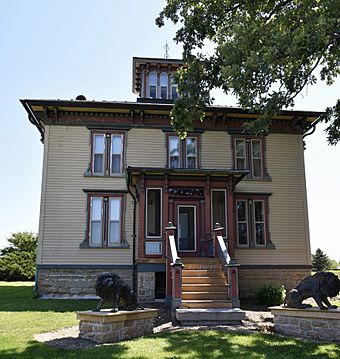Col. Nathan Whitney House facts for kids
Quick facts for kids |
|
|
Col. Nathan Whitney House
|
|
 |
|
| Nearest city | Franklin Grove, Illinois |
|---|---|
| Area | less than one acre |
| Built | 1860 |
| Architectural style | Italianate |
| NRHP reference No. | 90001726 |
| Added to NRHP | November 2, 1990 |
The Col. Nathan Whitney House is a historic house located near Franklin Grove, Illinois. It was built in 1860 for Colonel Nathan Whitney. This house is a great example of a building style called Italianate.
Contents
Discovering the Whitney House
This special house is found at 1620 Whitney Road, just south of Franklin Grove, Illinois. It was built in 1860 for a man named Colonel Nathan Whitney. He was a veteran who fought in the War of 1812.
Who Was Colonel Nathan Whitney?
Colonel Nathan Whitney and his family moved to the Franklin Grove area in 1836. They started a business called the Franklin Grove Nursery and Orchards. Their orchards grew very well and became quite successful.
Because of their success, Colonel Whitney had four houses built for his family on their land. The house built in 1860 was the fourth one.
What is Italianate Architecture?
The Col. Nathan Whitney House shows many typical features of the Italianate style. This style was popular in the mid-1800s. It often looked like Italian villas or farmhouses.
Key Features of the House
- Cupola: A small, dome-shaped tower called a cupola sits on top of the house's sloped roof. This is a classic Italianate feature.
- Decorative Brackets: You can see fancy decorations called brackets and dentils along the edges of the roof. These are also found on the front porch.
- Porch Details: The porch has more decorative brackets that separate the cupola's windows. Its railing, posts, and column tops also have beautiful designs.
- Tall Windows: The windows on the house and its cupola are thin and tall. This design makes the building look even taller. The thin columns supporting the porch roof also add to this feeling of height.
A Place in History
The Col. Nathan Whitney House was recognized for its historical importance. It was added to the National Register of Historic Places on November 2, 1990. This means it's a special building worth preserving.



